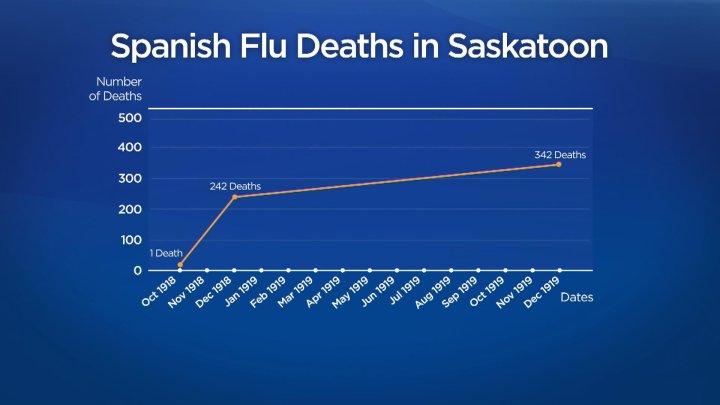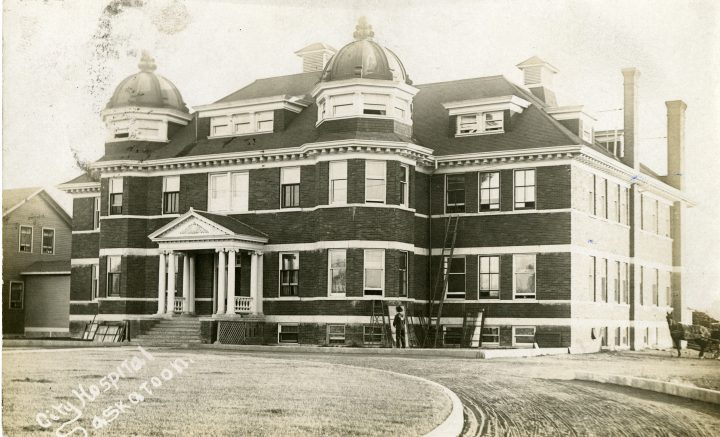COVID-19 isn’t the first pandemic to hit Saskatchewan, but it’s likely the first one you’ve lived through.

In 1918, it was almost the end of the First World War. Canadians started to hear about a new type of flu spreading across Europe and weren’t initially concerned.
“It’s really a lot like today,” City of Saskatoon archivist Jeff O’Brien said.
“We kind of watched it coming and it really starts out like someone else’s problem. By August the big news is it’s kind of ripping through American military bases.”
Spanish flu symptoms are similar to influenza today. Doctors said avoiding crowds, a healthy diet, good hygiene, fresh air and regular bowel movements were key to not getting the illness. If contracted, it did serious damage quickly.
- Posters promoting ‘Steal From Loblaws Day’ are circulating. How did we get here?
- Video shows Ontario police sharing Trudeau’s location with protester, investigation launched
- Canadian food banks are on the brink: ‘This is not a sustainable situation’
- Solar eclipse eye damage: More than 160 cases reported in Ontario, Quebec
On Oct. 10, 1918, the province was seeing cases of Spanish flu and declared influenza as a reportable disease, meaning you’d have to report it and quarantine if you contracted it.
“On Oct. 15, the legislature in Regina passes an order in council that gives local health boards, the municipal health boards, the right to close certain businesses,” O’Brien said.
Businesses shut down were primarily entertainment, such as bowling alleys, dance halls and theatres. The mayor at the time, Alexander MacGillivray Young, was also a physician. He wanted to have further closures where there were large gatherings, like churches, but this never happened.
Also on Oct. 15, 1918, the first confirmed case of Spanish flu was in Saskatoon. The first death was reported on Oct. 21, 1918. The business closures weren’t enough to flatten the curve, as death rates skyrocketed in November 1918.
The population of Saskatoon in 1918 was just under 21,000. By December 1918, there were 242 influenza deaths in the city. There would be 100 more over the next year.
Over 5,000 deaths were reported provincially within two years, with over half being reported in November 1918 alone.
Saskatoon City Hospital
The health care system was rapidly overwhelmed at this time. With a war going on, many resources and people were overseas. There were limited hospital beds and the University of Saskatchewan offered Emmanuel College to be used as an emergency hospital.
“At the peak of the disease, 130 patients were jammed into Emmanuel. They packed them in from the rafters right to the basement,” O’Brien said.
Although there are a few similarities between the Spanish flu outbreak in 1918 and the COVID-19 pandemic, there was arguably less support back then.
The federal government didn’t step in to prevent the spread of the illness. Canadians didn’t receive assistance, which caused lasting impacts economically.
“It’s not until after the 1930s we start seeing nationwide standards and nationwide systems of unemployment relief being implemented. But it starts here — it starts here in the wake of 1918,” O’Brien said.
Things feel a bit uncertain in our world right now and the same could be said in 1918. A lot has changed since then, but the tenacity of Canadians to get through tough times has seemed to stick around.
Questions about COVID-19? Here are some things you need to know:
Health officials caution against all international travel. Returning travellers are legally obligated to self-isolate for 14 days, beginning March 26, in case they develop symptoms and to prevent spreading the virus to others. Some provinces and territories have also implemented additional recommendations or enforcement measures to ensure those returning to the area self-isolate.
Symptoms can include fever, cough and difficulty breathing — very similar to a cold or flu. Some people can develop a more severe illness. People most at risk of this include older adults and people with severe chronic medical conditions like heart, lung or kidney disease. If you develop symptoms, contact public health authorities.
To prevent the virus from spreading, experts recommend frequent handwashing and coughing into your sleeve. They also recommend minimizing contact with others, staying home as much as possible and maintaining a distance of two metres from other people if you go out.
For full COVID-19 coverage from Global News, click here.






Comments